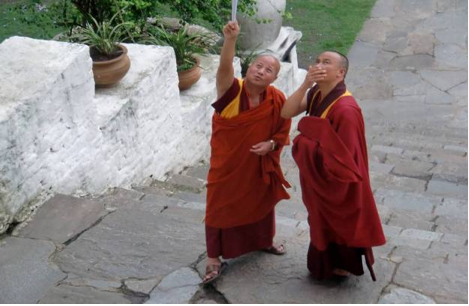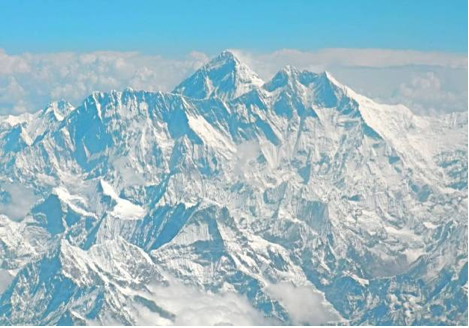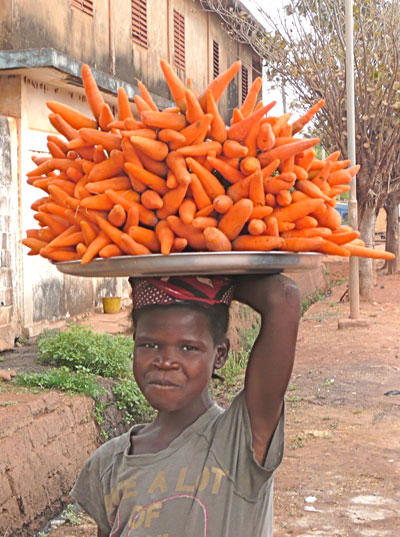Takshang (Tiger’s Nest) Monastery
The Kingdom of Bhutan
Most people have trouble finding Bhutan on a map. It is a small, land-locked country – about the size of Switzerland and smaller than South Carolina – nestled in the Himalayas with provinces of India on the west, south and east and Tibet/China to the north. The total population of the country is 700,000, with 120,000 in Thimphu, the capital. There is one airport in the country (at Paro) and essentially only one road, which connects (some of) the villages and valleys. Druk Air, the national airline and the only one that flies into the country, has two airplanes. The “Land of the Thunder Dragon” goes from 600 ft elevation in the south to 24,770 ft in the north – higher than anything in the continental U.S. by more than 10,000 ft. 70% of the country is forest. When thinking of Bhutan, think natural beauty and remoteness.
The king (the fifth in a dynasty that goes back to 1907) threw the people a curveball five years ago by announcing that the country should join the 21st century and become a democracy. No one thought that was a very good idea, but he was the king, so what are you going to do? They now have an elected legislature, but it is not clear what it does (kind of like in the U.S.).
By choice, Bhutan accepted no tourists until 1974. The Bhutanese were content in their isolation and most people had no clue – and couldn’t care less – about what was going on in the rest of the world (again, kind of like most Americans). Finally in the mid-1970s a fledgling tourist “industry” began to develop with the building of the Paro airport, the road (singular), and a few guesthouses. Now about 30,000 people a year visit this idyllic mountain realm, principally for cultural sightseeing, festivals and trekking.
The national sport of Bhutan is archery. We saw a “playing field” in the middle of Thimphu and the sport rivals British/Indian cricket in its obscurity. The field is 350 ft long with a tiny target at each end and two teams facing off, as in horseshoes. You couldn’t see the damn arrow in flight and it was nearly impossible to hit the target at that distance (no one did in the half hour that we watched). I asked our guide if Bhutan had ever won an Olympic medal in archery and he said, “Oh, no. We aren’t any good; it’s just what we do.”
Bhutan is primarily a Buddhist country with several spectacular monasteries and a welcoming Buddhist tradition. It was a 4½-hour round-trip hike, up and down 3000 ft, to get to the famous Takshang Monastery (see first photo); well worth the trek. A wealthy Hong-Kong businessman recently erected this 90 ft. statue of Buddha on a hillside overlooking one of the many pleasant valleys in Bhutan:

Compassion, selflessness, non-violence, friendliness and hospitality are hallmarks of Buddhism. The Buddhist monks of Bhutan are passive and devout in their prayer. These monks were very helpful in pointing the way to heaven (well, not heaven; but the next life):
In addition to its remoteness and natural beauty, three other things stand out to illustrate Bhutan’s uniqueness. While all countries have some measure of GNP (gross national product, a measure of economic activity), Bhutan is the only country in the world to focus on GNH – Gross National Happiness – as a national objective. This was an idea of the king, an effort to promote the well being of his people. (His own well being is pretty secure. In 1988 he married, in one ceremony, four sisters and has eight children by this arrangement. You might call it “all in the family”.) The concept of Gross National Happiness has gotten a lot of publicity around the world and both Britain and France currently have launched efforts to define criteria to consider the happiness of their citizens. Whatever may come of this, the genesis of the idea comes from Bhutan. (The Bhutanese, by the way, think it is all just a public relations ploy to attract attention and promote tourism – the ‘people on the street’ have no idea what it means.)
Another thing that I have not seen elsewhere, at least not in such abundance and with such clear and unabashed relish, is a symbol of friendship and fertility known around the world, but usually not displayed with such enthusiasm. Many homes and buildings proudly show, in drawing or woodcarving, an erect penis. It’s a bit of a surprise to see penises everywhere but, hey, it’s part of the culture. There was one semi-religious building our guide told us was a place where women came if they were having trouble getting pregnant. They were sent here for good luck. I asked him about women who came there who didn’t want to get pregnant; what about them? He said, “Send them to me.” I guess male guides are the same everywhere in the world.
The third uniqueness about Bhutan is its policy toward smoking. Here we have no-smoking zones in buildings, restaurants and airports, but in Bhutan the whole country is non-smoking. In January of this year a law went into effect banning the sale of tobacco in the entire country. You can bring cigarettes into the country if you show your purchase receipt and pay a 200% tax. That got the attention of several people on our flight when it was announced! In the first four months of this year 24 people have been arrested for “possession” and sentenced to 9 months to 4 years in jail. Outside one temple I told our guide, “Stop. We’re in the middle of a crime scene.” He looked at me quizzically and I pointed to a cigarette butt on the ground.
All-in-all Bhutan is a beautiful, gentle place. To get an entry visa you have to go with a licensed travel company and the cost (paid in advance) is $200 per person per day if you are part of a group, or $240 per person per day as a single person. This includes guide, transportation, hotel, entrance fees and meals so it’s not as expensive as it sounds, though the rate is going up in 2012. Get there before the rest of the world wakes up to this Shangri-la.
By the way, on the one-hour flight between Kathmandu, Nepal and Paro, Bhutan you fly right by Mt. Everest (29,035 ft – 8848 meters). Ask for window seat ‘A’ going to Bhutan and window seat ‘F’ coming back. If you are lucky with the clouds, this is the view you’ll get out the airplane window of the highest mountain in the world:






